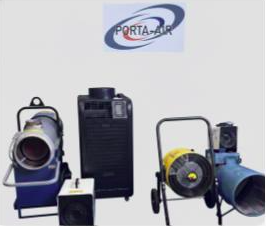
The industrial and construction sectors rely on powerful, specialized temporary heaters to keep projects moving. Choosing the right one is critical for safety, efficiency, and meeting project timelines.
Here are a breakdown of the main types of rental heaters and a guide on how to select the best fit for your application.
Primary Types of Industrial Rental Heaters
The biggest distinction in temporary heating is how the heat is generated and dispersed, specifically whether the combustion byproducts enter the space.
1. Direct Fired Heaters
- · How they work: The fuel (usually propane or natural gas) is burned directly in the airflow, and all of the combustion byproducts (including a small amount of moisture and carbon monoxide) are blown into the heated space.
- · Best for: Large, open, or well-ventilated areas where fresh air is constantly being introduced, such as outdoor/semi-enclosed construction sites, warehouses with open loading docks, or concrete curing areas.
- · Pros:
- o Highest Efficiency (up to 95%): Nearly all the fuel´s energy is converted into heat.
- o Most Cost-Effective to Run: Lower fuel costs compared to indirect-fired units.
- o Quick and Powerful: Deliver a large amount of heat fast.
- · Cons:
- o Must be Vented/Open: Cannot be used in occupied, tightly enclosed, or poorly ventilated spaces due to the exhaust fumes.
- o Adds Moisture: The combustion process adds water vapor to the air, making them unsuitable for drying applications (like fresh paint or drywall).
2. Indirect Fired Heaters
- · How they work: The fuel (diesel, propane, or natural gas) is burned inside a sealed heat exchanger. A fan blows clean air over the outside of this exchanger, and the exhaust fumes are vented safely outside via a flue.
- · Best for: Enclosed, occupied, or sensitive areas like offices, hospitals, finished buildings, tents/events, or when curing moisture-sensitive materials (like paint and drywall).
- · Pros:
- o Clean, Dry Air: No fumes or moisture are introduced into the space.
- o Safe for Enclosed Areas: Can be placed outside and ducted in, keeping noise and equipment out of the way.
- · Cons:
- o Lower Efficiency (around 80%): Some heat is lost through the exhaust stack.
- o Higher Rental/Operating Cost: More complex design means a higher rental price and fuel consumption than direct-fired units.
3. Electric Heaters
- · How they work: Use an electric current to heat an element, and a fan blows the warm air out. They produce heat instantly and are entirely combustion-free.
- · Best for: Small, fully enclosed, or sensitive areas where fuel storage/exhaust is prohibited or impractical, such as residential job sites, finished offices, small workshops, and areas with strict fire codes.
- · Pros:
- o Zero Emissions/Fumes: Completely safe for enclosed, occupied spaces.
- o Quiet and Portable: Very easy to maneuver and set up.
- · Cons:
- o Limited Heat Output: Cannot match the high BTUs of fuel-fired heaters for very large areas.
- o Power Requirements: Require adequate and correct voltage power (often 208V, 240V, or 480V, single- or three-phase). Running costs can be high if power is expensive.
4. Specialty Heaters
- · Hydronic/Ground Thaw Heaters: Circulate heated propylene glycol (an antifreeze solution) through a network of hoses or mats laid on the ground.
- o Best for: Thawing frozen ground before excavation or curing concrete slabs to prevent freezing and ensure proper strength.
- · Flameless Heaters: A variation of indirect-fired heaters that uses a hydraulic system or electric element to heat the air, providing a clean, dry, and safe heat source without an open flame.
- o Best for: Highly volatile or hazardous environments (e.g., oil and gas operations) where any combustion source is strictly forbidden.
How to Select the Right Temporary Heater
To select the correct heater, you need to answer four fundamental questions about your
application:
| Selection Factor | Key Question | Why it Matters | Recommended Type |
|---|---|---|---|
| 1. Environment | Is the space occupied, enclosed, or well-ventilated? | Determines safety requirements (fumes, fire risk). | Occupied/Enclosed: Indirect Fired, Electric, Flameless |
| Open/Well-Ventilated: Direct Fired (Highest efficiency) | |||
| 2. Application | Are you heating air for people, or materials for a process? | Material curing requires dry, consistent heat; ground thaw requires ground contact. | Curing/Drying (Paint, Drywall): Indirect Fired, Electric (Dry air is critical) |
| Ground Thaw/Concrete: Hydronic Heaters | |||
| 3. Size/Power | What is the size of the space (Cubic Feet) and the temperature increase needed? | This determines the required BTU (British Thermal Unit) output. | Small/Spot Heat: Electric, Small Direct Fired |
| Large/Industrial: High-Capacity Direct or Indirect Fired | |||
| 4. Available Utility | Do you have access to electricity, natural gas, or must you use fuel tanks (diesel/propane)? | The available power source limits your options. | No Power/Remote: Diesel/Propane (Requires fuel resupply) |
| Plenty of Electricity: Electric (Easy, no fuel handling) |
The BTU Calculation (Sizing)
The most important technical step is sizing. You need to calculate the approximate BTUs
required per hour:
Btu’s/Hr. = Length (Ft.) x Width (Ft.) x Height (Ft.) x Temperature Rise x Heat Loss Factor
- • Temperature Rise (Fahrenheit) = Desired Indoor Temperature – Ave. Expected
- Outdoor Temperature.
- • Heat Loss Factor: An insulation multiplier that accounts for heat loss.
- o 0.5: Excellent insulation, enclosed with insulation (modern office building).
- o 5: Ave./Poor insulation (typically construction site).
- o 9: No insulation (Tent or tarp enclosure).
Always consult with your rental provider. They have sizing tools and expertise to ensure you get the correct unit(s) for your specific project dimensions, insulation, and local weather conditions.


 (888) 519-1422
(888) 519-1422  FREE Spec-Out Request
FREE Spec-Out Request Rental Emergency 24/7
Rental Emergency 24/7